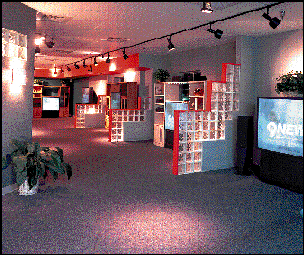New computerized interactive display techniques make selling big ticket electronics consumer friendly.

Above- Open display techniques are used to show several Home Theater units at once. The groups are separated by stair stepped partitions highlighted with glass block.
Home Theater displays are here to stay. The hot item of the late eighties is continuing to prove its fast track selling record throughout the nineties. New technological breakthroughs and lower prices are enabling more and more consumers to purchase these high tech systems. Because of the increasing interest in this product, retailers are finding that there are new display techniques that produce brisk home theater sales in their stores, whatever type of store that might be!
Traditionally, Home Theater has been exclusive to the consumer electronics retailer. However, a large percentage of home furnishings retailers are jumping into the act. They find that not only can they sell the substantial case pieces that these systems require, they can also generate big ticket add-on sales by offering the electronics to put into them. Moreover, consumer electronics retailers are finding that they too can realize big sales by selling the highly profitable case pieces as well as the electronics. Quite a few established consumer electronics stores are devoting large portions of their showrooms to the display of entertainment centers. Many are finding that selling furniture can be more lucrative than selling electronics. Both consumer electronics retailers and home furnishings retailers have a tremendous opportunity to generate incredible profits with Home Theater and all that it offers.
One of the most daunting aspects of selling home theaters in a furniture store is the misconception that it takes highly knowledgeable sales people to convince consumers to buy expensive high-tech systems. This just is not the case anymore. There are several easy to use interactive display systems on the market that can make selling Home Theater systems a breeze. By using touch screen computer monitors, consumers can try out several different systems in one area. They can experience the effect of the different sound and visual components and read the pricing and product specifications. Salespeople need only assist in demonstrating how the display screen works to the occasional consumer who is not acquainted with touch screen technologies. It can not get much simpler than to touch the computer screen and select the desired entertainment system. The computer will even print out the specifications and pricing for the customer.
HOME THEATER MEETS HIGH-TECH DISPLAY: Generally, the following display methods work equally well for furniture stores and consumer electronics stores alike. The first method is the conventional enclosed home theater room with a full surround sound system, upholstery settings and decorative accessories. The concept is to simulate a residential room setting. With the new computer selling tools mentioned earlier, several audio visual systems can be displayed in just one room. You can easily show more than one big screen television in this type of home theater. A prospective customer only has to touch the computer monitor in front of him or her to experience the different systems. Multiple speakers strategically placed throughout the room will provide the most effective home theater experience.
By far the most popular method of displaying home theaters is in an open, partially delineated room setting. This allows the consumers to see many home theater case pieces at one time. It obviously will require more square footage on your sales floor, however the ability to show multiple case pieces and multiple home theater systems at once can definitely justify the extra space needed.
Frequently, a decorative element such as a half-wall or 'stepped' wall creates the illusion of separation required between the units. Other details such as crown and base moldings further establish a residential feel. Because of the height of the case pieces, home theater displays are very successful when displayed against a back wall in your store. This enables the entire department to become a focal point when viewed from other areas in the store. A strong bold color that complements the wood tones in the case pieces will also create a highly dramatic effect. Don't be timid when it comes to using vivid colors in your home theater displays.
Used as a focal point, an open home theater display will create a spectacular and exciting department in any store. It creates an opportunity to add extra sizzle with strategically placed neon and colorful signing. Neon and signing are most effective when they are kept simple and easy to read. The color of the signs is liveliest when it contrasts strongly with the background wall color or colors. It produces maximum visual impact. Remember, it does not hurt to play up the high-tech angle of this type of product, even with very traditional case pieces. Decorative wall-mounted lighting fixtures work spectacularly well with this category of merchandise and helps to establish your theme and design concept for the entire department.
Whatever the type of home theater presentation you decide is best for your store, there are a few simple standards to follow to enhance the entire experience. You will need to include several speakers for each system. Front right and left speakers, a center speaker, left/right rear speakers and a sub woofer are typically needed for best acoustics. Also, as a general rule, the best viewing distance to a TV is five times the diagonal dimension of the screen.
The bottom line is to create an easy and inviting setting for your home theater displays. Consumers respond well to fun and familiar stimuli. A low-tech, user friendly, approach to displaying these high-tech products will establish brisk sales for just about any type of retailer who is ready for big sales from big TVs, big sound systems and big case pieces. Big bucks!
Curtis Manns is a principal with Curtis Randahl Associates a store planning firm based in San Francisco. Questions can be directed to FURNITURE WORLD Magazine at editor@furninfo.com.